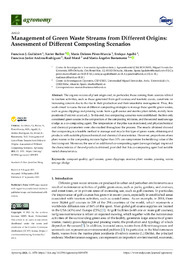Please use this identifier to cite or link to this item:
https://hdl.handle.net/11000/34411Full metadata record
| DC Field | Value | Language |
|---|---|---|
| dc.contributor.author | Andreu Rodriguez, Francisco Javier | - |
| dc.contributor.author | Guilabert, Francisco J | - |
| dc.contributor.author | Barber, Xavier | - |
| dc.contributor.author | Pérez Murcia, Mª Dolores | - |
| dc.contributor.author | Agulló Ruiz, Enrique | - |
| dc.contributor.author | Moral, Raúl | - |
| dc.contributor.other | Departamentos de la UMH::Ingeniería | es_ES |
| dc.date.accessioned | 2025-01-11T16:40:25Z | - |
| dc.date.available | 2025-01-11T16:40:25Z | - |
| dc.date.created | 2021-09 | - |
| dc.identifier.citation | Agronomy 2021, 11(9), 1870 | es_ES |
| dc.identifier.issn | 2073-4395 | - |
| dc.identifier.uri | https://hdl.handle.net/11000/34411 | - |
| dc.description.abstract | The organic wastes of plant origin and, in particular, those coming from sources related to tourism activities, such as those generated from golf courses and touristic coasts, constitute an increasing concern due to the rise in their production and their unsuitable management. Thus, this work aimed to assess the use of different composting strategies to manage these specific green wastes, such as grass clippings and pruning waste from a golf course and marine plant debris, mainly from posidonia (Posidonia oceanica L.). To this end, two composting scenarios were established: the first only considered green wastes in the composition of the composting mixtures, and the second used sewage sludge as a co-composting agent. The temperature of the piles was monitored, and physicochemical and chemical parameters were also studied throughout the process. The results obtained showed that composting is a feasible method to manage and recycle this type of green waste, obtaining end products with suitable physicochemical and chemical characteristics. However, proportions of sea plant wastes in the composting mixture higher than 30% can compromise the fertilizing value of the final compost. Moreover, the use of an additional co-composting agent (sewage sludge) improved the characteristics of the end products obtained, provided that this co-composting agent had suitable initial characteristics. | es_ES |
| dc.format | application/pdf | es_ES |
| dc.format.extent | 9 | es_ES |
| dc.language.iso | eng | es_ES |
| dc.publisher | MDPI | es_ES |
| dc.rights | info:eu-repo/semantics/openAccess | es_ES |
| dc.rights | Attribution-NonCommercial-NoDerivatives 4.0 Internacional | * |
| dc.rights.uri | http://creativecommons.org/licenses/by-nc-nd/4.0/ | * |
| dc.subject | compost quality | es_ES |
| dc.subject | golf course | es_ES |
| dc.subject | grass clippings | es_ES |
| dc.subject | marine plant wastes | es_ES |
| dc.subject | pruning waste | es_ES |
| dc.subject | sewage sludge | es_ES |
| dc.title | Management of Green Waste Streams from Different Origins: Assessment of Different Composting Scenarios | es_ES |
| dc.type | info:eu-repo/semantics/article | es_ES |
| dc.relation.publisherversion | https://doi.org/10.3390/agronomy11091870 | es_ES |

View/Open:
agronomy-11-01870-v2.pdf
631,11 kB
Adobe PDF
Share:
.png)
